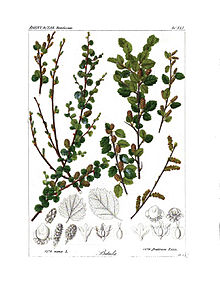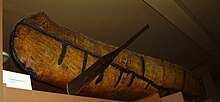Birch trees
| Birch trees | ||||||||||||
|---|---|---|---|---|---|---|---|---|---|---|---|---|

Silver birch ( Betula pendula ) illustration . |
||||||||||||
| Systematics | ||||||||||||
|
||||||||||||
| Scientific name | ||||||||||||
| Betula | ||||||||||||
| L. |
The birch ( Betula ) constitute a genus within the family of birch family (Betulaceae).
The word birch (from Old High German bircha ) can be traced back to an Indo-European term (* bherHg̑o ) and means something like “shiny, shimmering” in reference to the light bark (see also Middle High German bereht “shining”).
description
Vegetative characteristics
Birch species are deciduous, deciduous trees or shrubs . They belong to the very fast and tall growing trees and can reach heights of up to 7 meters after just six years; fully grown, they can be up to 30 meters, in individual cases even higher. They grow with single or often with multiple trunks. Single copies can reach an age of up to 160 years.
The bark is particularly noticeable in many birch species , its color ranges from almost black to dark and light brown to white; it is initially smooth, later thin, often paper-like pieces peel off, finally it tears open horizontally. There are often distinct, mostly dark, lenticels that sometimes enlarge horizontally.
The light and, depending on the type, soft to more or less hard wood is almost white to reddish-brown with a fine grain. Long and short shoots can be distinguished on young branches. The branches are sometimes fragrant. Several smooth scales overlap on the winter buds.
The alternate, mostly in two rows, often arranged at short shoots leaves are divided into petiole and leaf blade. Depending on the species, with lengths of 0.5 to 10 (rarely up to 14) centimeters and widths of 0.5 to 8 centimeters, the egg-shaped to delta-shaped, elliptical or almost circular leaf blades are bald to differently hairy, sometimes resinous-glandular. There is pinnate veins . The leaf margins are, depending on the species, sawn to mostly double-sawn or, less often in the Nordic dwarf shrub species, wavy to slightly rounded lobes. The stipules often fall off early.
Generative characteristics
All birch species are single-sexed ( monoecious ). The inflorescences are called catkins, with the female below the male on the branches. The male inflorescences hang individually in small groups, mostly at the ends of the branches. They are formed in the previous growing season and can already be seen during winter. In the male catkins there are always three flowers per scale. The male flowers usually contain only two to three (one to four) stamens with stamens divided near their base to almost the anthers. All birches are wind pollinated ( anemophilia ), which is why they release large amounts of pollen during the flowering period from late March to late April . The durable, female inflorescences are usually single upright and are ovate to cylindrical. At the same time as the leaves begin to emerge, the female inflorescences, which were previously protected in buds, develop. In the female catkins there are rarely one to mostly three flowers per scale ( bract ).
The upright to hanging fruit clusters have thickened and leathery, but not lignified, scales. The scales usually fall off individually when the seeds are released, or in a few species they remain in the fruit cluster over the winter. Winged nuts (samara) are formed. On two sides of the seeds there are membranous, more or less broad wings. The fruits ripen from September to October.
The basic chromosome number is x = 14.
Himalayan birch catkins ( Betula utilis )
Ripe fruit cluster of the gray birch ( Betula populifolia )
Ripe fruit cluster of the sugar birch ( Betula lenta )
Winged silver birch nut ( Betula pendula ). The small wings transport the fruits over long distances.
ecology
Many bird species rely on birch trees, e. For example, the birch siskin and the black grouse use birch buds and seeds as an important winter food. The tree itself is a habitat for numerous fungi, lichens and mosses as well as for insects and mammals . Some live as parasites or in symbiosis in, on and on the birch.
There are 118 species of caterpillars that use the birch (down and down birch) as a forage plant. This makes the birch third of the most popular butterfly food plants.

Locations
Birch trees are often pioneer plants in open spaces. Birch species make only minor demands on soil and climate . Birch species thrive on both dry and wet soils , in heather areas , on dunes and on moorland .
Significance for pollen allergy sufferers
Birch pollen is a highly potent allergen . According to the ENT clinic of the University of Vienna , the percentage of allergy sufferers who react specifically to birch pollen has increased from 35% to 50% of all pollen allergy sufferers over the past 20 years . Nevertheless, due to their beautiful white color, birch trees are also often planted in cities as avenue trees. As with all pollen, the birch pollen volume changes slightly every year. In Germany they occur annually from around the end of March to the beginning of June, with the main flowering taking place around 2 weeks in mid-April.
use
bad luck

Birch pitch , produced from birches through smoldering and dry distillation , has been proven to be the first systematically produced plastic in human history for the permanent connection of stone wedges, plant fibers and wooden handles, both by Neanderthals and by modern humans ( Homo sapiens of Cro- Magnon epoch ).
Ornamental plant
Birch species are often planted as an ornamental plant in gardens, parks and avenues due to the white color of the bark .
Use of wood
The main wood suppliers in Central Europe are the sand and bog birch trees. As sapwood species, they do not form any heartwood or color core. The wood is evenly colored yellowish white, reddish white or light brownish and has a silky sheen. As a typical color property, the wood has patchy light-dark-light effects that are caused by irregularities in the grain. With older wood, a yellowish-red to brown false core can be formed. The annual rings are delimited by narrow and dense latewood strips. In overall character, birch wood is a light-colored and simple, depending on the grain, very decorative timber. Special features are the flame and ice birch patterns that occur especially in the sand birch, which can be traced back to the highly irregular fiber courses. The most expensive type is the wood of the Karelian burl birch, whose characteristic grain is characterized by dark crescent-shaped deposits and particularly wild, irregular structures.
Birch wood cannot be used as construction timber because of its low load-bearing capacity and durability . It is a light and fine-grained wood. It was used to make wooden shoes and clothespins , among other things . It is easy to carve and turn, but difficult to split. In Germany, birch wood is mainly used as peeled veneer or processed into plywood panels. Solid wood and sliced veneers are also used to manufacture furniture. Nordic wood carvers make traditional drinking vessels, the guksi , from the burl wood . The chip maker was dependent on the birch. Shavings and sands from this wood are the best as they hardly develop any smoke. These were used for lighting in winter.
Decorative firewood is also popular as firewood . Thanks to the essential oils , birch wood burns even when it is fresh. Birch bark is therefore well suited as tinder and for lighting a fire.
Bark and sticks
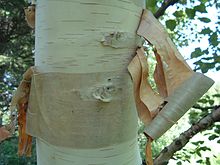
The birch bark was also used in a variety of ways, for example for chip boxes. In Finland in particular , it was also used to make shoes, backpacks and other items. Storage containers for flour, tea and especially bread, as they were produced and used in Siberia and are being used again, have also been available in this country in recent years, especially in ecological shops and via the corresponding mail order business. These containers take advantage of the antiseptic properties of birch bark. The North American Mi'kmaq , an Indian people in northeastern Canada , are a vivid example of the diverse uses of birch bark for the manufacture of canoes , containers and vessels , as wall material for their wigwams and as a writing surface for drawings and symbols , right up to the death dress at burial and the USA . Birch bark was also used as a writing material in various places around the world, including in Novgorod (cf. birch bark texts ) and in the Himalayan region .
The outer part of the bark, divided into two layers, was used to make birch tar and birch oil . The inner part is edible and can be cooked like spaghetti .
The dying rural handicrafts use the birch in many ways. The broom-maker presents from their branches and twigs, known as spider veins, one for rough paving hardly be surpassed broom ago. Bush binders prefer to bundle birch twigs to be fastened elements for dike and hydraulic engineering . Tufts of birch twigs are used in the Finnish and Russian saunas as a bath swab (Russian Wenik , Finnish vihta or vasta ) to knock off the body. In addition, the birch rod , a tied bundle of defoliated birch twigs, was the most popular punishment instrument in Central Europe , Northern Europe and Northern Asia for centuries .
Medicinal ingredients
The leaves ( Betulae folium ) Birch of most species contain significant amounts of flavonoids , saponins , tannins , essential oils and vitamin C . The bark contains phytosterols and terpenes such as betulin , betulinic acid and lupeol ; the bark juice u. a. Invert sugar so that it can also be fermented. In Finland the sugar substitute xylitol is obtained from birch trees. In Central Europe , the native sand birch in particular has historically been used in folk medicine . Its components are particularly blood-purifying, diuretic and stimulating, which is why it is used today in herbal medicine ( phytotherapy ).
The leaves, the leaf buds and the birch sap (obtained by tapping) are used. In medicine the leaves, because of their diuretic effect in rheumatism , gout and dropsy use. The collection time for leaf buds is March, for birch sap March to May and for leaves May to June.
Birch sap is also used to clean poorly healing wounds and treat rashes and dandruff .
Applications of cosmetics
The birch sap that flows for a few weeks in spring is obtained by tapping the trunk or cutting branches . It is said to be good against hair loss . Mostly in the last century birch sap was used to make birch hair tonic. The juice can be used externally or drunk directly.
food
Unlike most tree leaves, birch leaves are edible. Since the birch sap is sugary, it can be enjoyed in fermented form as birch wine, a peasant drink that is still popular in Russia today. Birch wine was also used as a tonic for impotent men.
Damage to the tree
Intensive extraction of the birch sap can cause damage and infections to the tree.


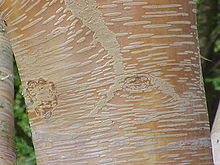


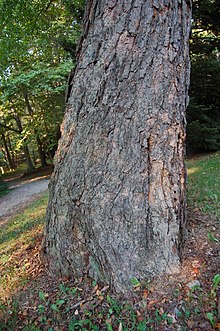


Systematics and distribution
The generic name Betula was in 1753 by Carl von Linné in Species Plantarum , 2, p. 982 f. first published . In 1929, Betula alba L. was established as the lectotype . The genus Betula belongs to the subfamily Betuloideae within the Betulaceae family .
The up to 100 birch species occur in large parts of the northern hemisphere , in Europe , in North America (especially on their east coasts) and in Asia to Japan .
There are (35 to 100) about 64 species and many nature hybrids in the genus birch ( Betula ):
- Red Chinese birch ( Betula albosinensis Burkill ): It is native to northern and central China. It is known as the subspecies Betula utilis subsp. By Ashburner and McAllister in 2013 . albosinensis (Burkill) Ashburner & McAll. to the Himalayan birch ( Betula utilis D.Don ).
- Yellow birch ( Betula alleghaniensis Britton , Syn .: Betula lutea auct.): It is widespread in eastern Canada and in the USA.
- Betula alnoides Buch.-Ham. ex D.Don : The distribution area extends from the Himalayas to southern China.
- Betula × alpestris Fr. (= Betula nana × Betula pubescens )
- Betula × aurata Borkh. (= Betula pendula × Betula pubescens , Syn .: Betula × atrata Domin , Betula × obscura Kotula ): It occurs in Europe.
- Betula ashburneri McAll. & Rushforth : The distribution area of the species first described in 2011 ranges from Bhutan to Sichuan and Yunnan .
- Betula × avatshensis Kom. (= Betula ermanii × Betula pendula subsp. Mandshurica ): It occurs in Kamchatka and northern Japan.
- Betula baschkirica Tzvelev : The home is European Russia.
- Betula bomiensis P.C.Li : The homeland is south-eastern Tibet .
- Betula × bottnica Mela : The home is Northern Europe.
- Blue birch ( Betula × caerulea Blanch. = Betula papyrifera var. Cordifolia × Betula populifolia ): It occurs in Canada and the northeastern United States.
- Betula calcicola (WWSm.) PCLi : Home is southwest Sichuan and northwest Yunnan.
- Betula celtiberica Rothm. & Vasc. : This endemic occurs only in northwestern Spain and in northern Portugal.
- Betula chichibuensis H.Hara : This endemic occurs only on the Japanese island of Honshu .
- Betula chinensis Maxim. , Syn .: Betula fargesii Franch. , Betula ceratoptera G.H.Liu & YCMa , Betula jiaodongensis S.B.Liang : Home is Korea and northern and eastern China.
- Betula cordifolia rule : The home is eastern Canada and the USA.
- Betula coriaceifolia V.N.Vassil. : The home is Central Asia.
- Hazelnut-leaved birch ( Betula corylifolia Regel & Maxim. ): This endemic occurs only on the Japanese island of Honshu .
- Korean birch ( Betula costata Trautv. ): Home is Korea and Russia's Far East .
- Betula cylindrostachya Lindl. ex Wall. (Syn .: Betula fujianensis J.Zeng, Jian H.Li & ZDChen ): The range extends from the Himalayas to China.
- Betula dahurica Pall. (Syn .: Betula davurica Pall. Orth. Var.): It occurs in three varieties from south-eastern Siberia to northern and central Japan.
- Betula delavayi Franch. (Syn .: Betula forrestii (WWSm.) Hand.-Mazz. ): The homeland is southeastern Tibet, southwestern Sichuan , northwestern Yunnan and western Hubei in China.
- Betula × dosmannii McAll. = Betula ermanii × Betula maximowicziana : It occurs in Japan.
- Betula × dugleana Lepage = Betula glandulosa × Betula neoalaskana : It occurs in Alaska and Yukon.
- Betula × dutillyi Lepage = Betula glandulosa × Betula minor : It occurs in eastern Canada.
- Betula × eastwoodiae coffin. = Betula glandulosa × Betula occidentalis : It occurs from Alaska to Colorado.
- Erman's birch , also golden birch, Kamchatka birch ( Betula ermanii Cham. , Incl.Betula lanata (Regel) Vassilcz .; Syn .: Betula ganjuensis Koidz. , Betula paraermanii V.N.Vassil. , Betula shikokiana Nakai ): It comes in two Varieties from Siberia to Japan.
- Betula falcata V.N.Vassil. : The home is Central Asia.
- Betula fargesii Franch. : The home is China.
- Betula fruticosa Pall. (Syn .: Betula fusca Pall. Ex Georgi , Betula divaricata Ledeb. , Betula middendorffii Trautv. & CAMey. , Betula ovalifolia Rupr. , Betula paishanensis Nakai , Betula tatewakiana M. Ohki & S.Watan. ): It comes from southern Siberia to northern China and northern Japan.
- Glandular birch ( Betula glandulosa Michx. ): The range extends from Siberia to Mongolia and North America.
- Betula globispica Shirai : This endemic occurs only on the Japanese island of Honshu .
- Betula gmelinii Bunge (Syn .: Betula apoiensis Nakai ): It occurs from Siberia to Japan.
- Ornamental cherry birch ( Betula grossa Sieb. & Zucc. , Syn .: Betula ulmifolia Sieb. & Zucc. ): The home is southern and central Japan.
- Betula gynoterminalis Y.C.Hsu & CJWang : It only occurs in northwestern Yunnan .
- Betula hainanensis J.Zeng, BQRen, JYZhu & ZDChen : It wasfirst describedin 2014 from Hainan .
- Betula × heptopotamica V.N.Vassil. = Betula fruticosa × Betula pubescens : It occurs in Central Asia.
- Betula honanensis S.Y.Wang & CLChang : It is only found in Henan .
- Betula × hornei E.J.Butler = Betula papyrifera × Betula nana : It occurs in Alaska and Yukon .
- Shrub Birch ( Betula humilis cabinet ; Syn .: Betula fruticans Pall. Orth. Var., Betula extremiorientalis Kuzen. & VNVassil. ): The home includes subarctic and subalpine Eurasia to Korea.
- Betula × intermedia (Hartm.) E. Thomas ex Gaudin = Betula nana × Betula pubescens : It occurs in subarctic and subalpine Eurasia.
- Betula × jackii C.K. Schneid. = Betula lenta × Betula pumila : It occurs in the northeastern United States.
- Betula karagandensis V.N.Vassil. : The home is Central Asia.
- Betula × koehnei C.K. Schneid. = Betula papyrifera × Betula pendula
- Betula klokovii Zaver. : It only occurs in Ukraine .
- Betula kotulae Zaver. : It only occurs in Ukraine.
- Betula k Weichowensis Hu (Syn .: Betula insignis Franch. ): It occurs from southern China to Vietnam.
- Sugar birch ( Betula lenta L. , incl. Betula uber (Ashe) Fernald ): It is native to eastern Canada and the eastern USA.
- Betula luminifera H.JPWinkl. : The home is central and southern China.
- Linden-leaved birch , also bronze birch, emperor birch ( Betula maximowicziana rule ): The homeland includes the southern Kuril Islands to northern and central Japan.
- Caucasian birch ( Betula medwediewii rule ): The homeland includes northeastern Turkey to northwestern Iran.
- Betula megrelica Sosn. : This endemic occurs only in western Georgia .
- Betula michauxii Spach : The home is eastern Canada.
- Betula microphylla Bunge (Syn .: Betula halophila Ching ): The home extends from Central Asia to northwestern China and from southern Siberia to northern Mongolia.
- Betula × minor (Tuck.) Fernald = Betula cordifolia × Betula glandulosa : It occurs in eastern Canada and the northeastern United States.
- Dwarf birch , also polar birch ( Betula nana L. , Syn .: Betula exilis Sukaczev ): The home is the subarctic and the mountains of Europe; it is also found in eastern subarctic North America. It is also found in Central Europe.
- Black birch , also river birch ( Betula nigra L. ): The home is the central and eastern USA.
- Water birch ( Betula occidentalis Hook. , Syn .: Betula fontinalis coffin. ): It occurs from subarctic North America to the western and central United States.
- Paper birch , also canoe birch or American white birch ( Betula papyrifera Marshall , Syn .: Betula excelsa Aiton , Betula lyalliana Koehne nom. Nud., Betula kenaica W.H. Evans ): The home is subarctic America with Canada and the USA south to Virginia.
- Betula × paramushirensis Barkalov = Betula ermanii × Betula pumila : It occurs only on the Kuril Islands .
- Silver birch , also common birch, sand, weeping, warty or white birch ( Betula pendula Roth , Syn .: Betula verrucosa Ehrh. , Betula tristis Wormsk. Ex Link , Betula aetnensis Raf. Ex J. Presl & C .Presl , Betula ferganensis V.N.Vassil .; Including Betula platyphylla Sukaczev , Betula mandshurica (Regel) Nakai , Betula szechuanica (CKchneid.) C.-A. Jansson , Betula austrosichotensis V.N.Vassil. & VIBaranov , Betula neoalaskana Sarg. , Betula neoalaskana Sarg Britton , Betula japonica (Miq.) Siebold ex HJPWinkl. ): The homeland is temperate Eurasia and North Africa. It also occurs in Central Europe. One can distinguish three subspecies.
- Betula × plettkei boy = Betula nana × Betula pendula : It occurs in Europe.
- Gray birch , also poplar-leaved birch ( Betula populifolia Marshall ): The home extends from southeastern Canada to northwestern South Carolina .
- Betula potamophila V.N.Vassil. : The home is Central Asia.
- Betula potaninii Batalin (Syn .: Betula jiulungensis P.C.Li ex Q.Lin ): It occurs in the Chinese provinces of Gansu , Shaanxi and Sichuan .
- Betula psammophila V.N.Vassil. : The home is Central Asia.
- Downy birch , Krummästige birch ( Betula pubescens Ehrh. , Syn .: Betula alba L. , Betula czerepanovii N.I.Orlova , Betula tortuosa Ledeb. , Incl. Betula litwinowii Doluch. The home:) Greenland and Eurasia . It also occurs in Central Europe. Several varieties are known.
- American birch ( Betula pumila L. ): It is native to North America.
- Betula × purpusii C.K. Schneid. = Betula glandulifera × Betula lutea , Syn .: Betula × murrayana B.V. Barnes & Dancik : It occurs from southern Ontario to the northeastern United States.
- Caucasian shrub birch ( Betula raddeana Trautv. ): The home is the Caucasus region .
- Betula × raymundii Lepage = Betula populifolia × Betula pumila var. Glandulifera : It occurs in eastern Canada.
- Betula saksarensis Polozhij & ATMalzeva : This endemic occurs only in Khakassiya in Siberia.
- Betula × sandbergii Britton = Betula glandulifera × Betula papyrifera : It occurs from Canada to the northern United States.
- Betula × sargentii Dugle = Betula glandulosa × Betula pumila : It occurs in Canada.
- Betula saviczii V.N.Vassil. : The home is Central Asia.
- Iron birch ( Betula schmidtii rule ): It occurs from Russia's Far East to Korea and northern and central Honshu.
- Betula skvortsovii McAll. & Ashburner : It was first described in 2013 and occurs from Qinghai to northwestern Yunnan.
- Betula sunanensis Y.J.Zhang : It occurs in the Chinese province of Gansu .
- Sichuan birch ( Betula szechuanica (CKSchneid.) C.-A.Jansson , Syn .: Betula rockii (Rehder) C.-A.Jansson ): The home is southeastern Tibet and China. Some authors call it the subspecies Betula pendula subsp. szechuanica (CKSchneid.) Ashburner & McAll. posed to Betula pendula .
- Betula tianschanica Rupr. (Syn .: Betula dolicholepis Ovcz., Czukav. & Shibkova , Betula jarmolenkoana Golosk. , Betula kirghisorum Sav.-Rycz. , Betula korshinskyi Litv. , Betula margusarica V.N.Vassil. , Betula ovczinnikovii V.N.Vassil. , Betula pamirica Litv. , Betula procurva . Litv , Betula active liana . V.N.Vassil , Betula saposhnikovii Sukaczev , Betula seravschanica . V.N.Vassil , Betula schug anica (. B.Fedtsch) Litv. , Betula tadzhikistanica V.N.Vassil. , Betula turkestanica Litv. , Betula tuturinii V.N.Vassil. ): The Home ranges from Central Asia to Mongolia.
- Betula × uliginosa Dugle = Betula pendula subsp. mandshurica × Betula glandulosa : It occurs in Canada.
- Betula × utahensis Britton = Betula occidentalis × Betula papyrifera : It occurs from Yukon to Utah.
- Northern birch ( Betula utilis D.Don , including Betula chitralica Browicz , Betula kunarensis Browicz , Betula pyrolifolia V.N.Vassil. And Betula jacquemontii Spach ): There are four subspecies. The homeland stretches from Afghanistan to China.
- Betula × vologdensis Tzvelev = Betula humilis × Betula nana : It occurs in northeastern Europe.
- Betula × winteri Dugle = Betula pendula subsp. mandshurica × Betula papyrifera : It occurs in subarctic America and in western Canada.
- Betula wuyiensis J.B.Xiao : The home is Fujian .
- Betula × zimpelii boy = Betula humilis × Betula pendula : It occurs in Central Europe.
- Betula zinserlingii V.N.Vassil. : The home is Central Asia.
Birch trees in customs and popular belief
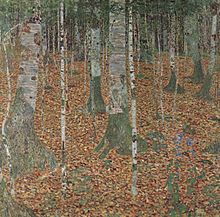
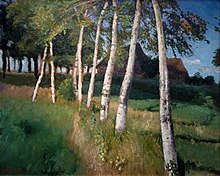
The birch played a major role in the Germanic and Slavic popular beliefs . It was dedicated to the goddess Freya . The custom of fetching a maypole from the forest to set up on the village square also dates from this time . The awakening spring was brought to the village. The same custom still lives on today in the form of the maypole. Bachelors “stick” a more or less large “May” to their loved ones - they decorate a tree (usually a birch) or at least a birch branch and attach it to the house or window of the chosen one. This tree is adorned with ribbons made of colored crepe or tissue paper. The song " Winter has passed , I see the May glow ..." speaks of it.
The birch, as a symbol of fertility, used to be a helper in need of love. This purpose is almost forgotten today. Its branches, bark and leaves had to be used for all sorts of obscure means and customs, from which one hoped to improve sexual needs.
The mythological significance of the birch as the “tree of protection” should also be emphasized. In traditional folk beliefs, birch trees were planted, especially in rural areas, as road markings to prevent accidents on busy, unlit avenue streets and confusing travel routes, as their light bark makes them easily recognizable in the dark. In the Indian folk wisdom trees have always symbolized living beings of wisdom, whose language one can tap into, shamanism . In the popular piety of the Catholic Church, which also includes mythological knowledge, the birch is used regionally for Corpus Christi when countless young specimens in Catholic villages line the streets through which the processions lead.
The birch is the symbol of Estonia . In Russia , Finland and Poland the tree is considered a national symbol , comparable to the “ German oak ”.
According to popular belief , birch trees should attract lightning . For this reason, birch trees were rarely tolerated near rural properties in the past . According to an old legend, the last world battle will take place under a single birch tree. However, these two unpleasant points of view are an exception. The birch is mainly associated with pleasant things. The birch has even been considered a sacred tree since ancient times, symbolizing the virgin goddess for the fertility festivals in spring. In many areas the birch was also revered as a symbol of youth and spring.
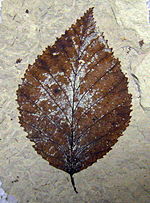
literature
- Kennith Ashburner, Hugh A. McAllister: The genus Betula: a taxonomic revision of birches. Royal Botanic Gardens Kew, 2013, ISBN 978-1-84246-141-9 , pp. 1-431.
- John J. Furlow: Betulaceae. In: Flora of North America Editorial Committee (Ed.): Flora of North America North of Mexico . Volume 3: Magnoliophyta: Magnoliidae and Hamamelidae . Oxford University Press, New York / Oxford a. a. 1997, ISBN 0-19-511246-6 (English, efloras.org - sections description and systematics).
- Pei-chun Li, Alexei K. Skvortsov: Betulaceae. In: Wu Zheng-yi, Peter H. Raven (Ed.): Flora of China . Volume 4: Cycadaceae through Fagaceae . Science Press / Missouri Botanical Garden Press, Beijing / St. Louis 1999, ISBN 0-915279-70-3 , pp. 304 (English, efloras.org ).
- Yasin J. Nasir: Betulaceae. In: Eugene Nasir, SI Ali (Ed.): Flora of West Pakistan. Volume 95, 1975, Stewart Herbarium, Rawalpindi ( efloras.org ).
- Pia Järvinen, Anna Palmé, Luis Orlando Morales, Mika Lännenpää, Markku Keinänen, Tuomas Sopanen, Martin Lascoux: Phylogenetic relationships of Betula species (Betulaceae) based on nuclear ADH and chloroplast matK sequences. In: American Journal of Botany. Volume 91, No. 11, 2004, pp. 1834-1845, doi: 10.3732 / ajb.91.11.1834 .
Individual evidence
- ↑ Hermann H. Hacker: Butterfly on birch. (PDF) In: www.lwf.bayern.de. State Institute for Forestry and Forestry, accessed on February 4, 2018 .
- ^ Text and calendar at the German Pollen Information Service Foundation.
- ↑ argeholz.de
- ↑ Birch bark can production. In: dreigliederung.de. Retrieved January 4, 2009 .
- ↑ birch. In: heilkraeuter.de. Retrieved May 4, 2007 .
- ↑ Edible trees. (No longer available online.) WDR service time , November 28, 2012, archived from the original on December 5, 2012 ; accessed on January 15, 2017 .
- ↑ Doris Laudert: Myth Tree. BLV, Munich 2004, p. 63.
- ^ Linné 1753 Scanned in at biodiversitylibrary.org .
- ^ Betula at Tropicos.org. Missouri Botanical Garden, St. Louis, accessed January 15, 2017.
- ^ A b Betula in the Germplasm Resources Information Network (GRIN), USDA , ARS , National Genetic Resources Program. National Germplasm Resources Laboratory, Beltsville, Maryland. Retrieved January 15, 2017.
- ↑ a b Kennith Ashburner, Hugh A. McAllister: The genus Betula: a taxonomic revision of birches. Royal Botanic Gardens Kew, 2013, pp. 1-431.
- ↑ a b c d e f g h i j k l m n o p q r s t u v w x y z aa ab ac ad ae af ag ah ai aj ak al am an ao ap aq ar as at au av aw ax ay az ba bb bc bd be bf bg bh bi bj bk bl bm bn bo bp bq br bs bt bu bv bw bx by bz ca cb cc cd ce cf cg ch ci cj Rafaël Govaerts (Ed.): Betula. In: World Checklist of Selected Plant Families (WCSP) - The Board of Trustees of the Royal Botanic Gardens, Kew . Retrieved September 18, 2018.
- ↑ Barroso Agro-sylvo-pastoral system. FAO / ADRAT, March 2018, accessed October 28, 2019 .
- ^ Heinrich Marzell : The German trees in folklore, 12: The birch. In: Mitteilungen der Deutschen Dendrologische Gesellschaft 46, 1934, pp. 121–131.
